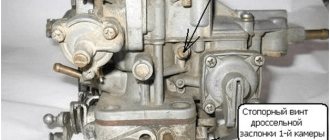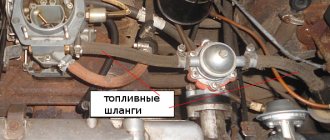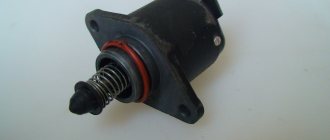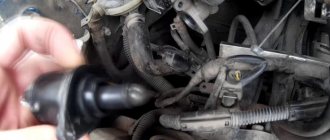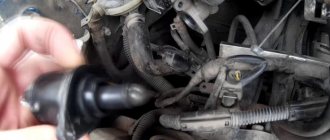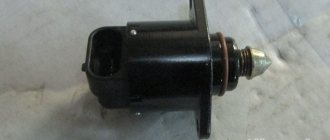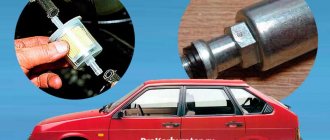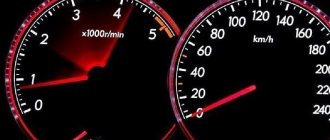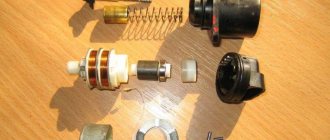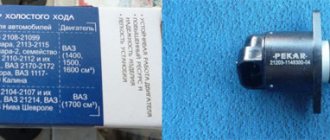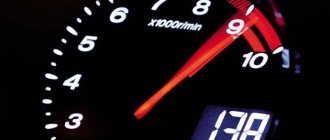The VAZ 2107 is not the best model among cars in its class when compared with foreign equivalents. However, thanks to its low price and accessible service, the car has been popular throughout the post-Soviet territory for many years. The car was produced from 1982 until 2014. That is, the oldest model is more than 30 years old. During such a period of operation, the owner will be able to encounter all types of faults and investigate most of the causes of problems.
After several years of operation, the VAZ 2107, as well as the almost identical model 2105, begins to show a new character with changes not for the better. Malfunctions associated with the power unit and its body kit are of a different nature, but are symptomatic:
- the engine stalls periodically;
- does not maintain stable speed;
- unstable operation at idle;
- hard to start;
- insufficient power;
- increased fuel consumption.
All malfunctions appear for two reasons: violation of adjustments or wear of parts.
Gasoline engine does not idle
Let's start with the fact that this malfunction indicates two possible causes: failure of individual mechanisms, components or sensors, as well as severe contamination of certain elements. In both the first and second cases, it is necessary to carry out a diagnosis. The engine on injection and carburetor cars can most often stall at idle in the following cases:
- the idle air regulator (IAC) has failed;
- the throttle valve is dirty or malfunctioning;
- the carburetor channels are clogged or the fuel jet XX is dirty;
- the performance of injection nozzles is reduced or impaired;
- the mesh of the electric/mechanical fuel pump is clogged, malfunctions of this unit have occurred;
- there was a decrease in the throughput of the fuel filter;
- the air filter is dirty, air leaks at the inlet;
- failure of the mass air flow sensor, throttle position sensor, etc.;
- clogging of the engine crankcase ventilation system;
If the car immediately stalls or the speed fluctuates noticeably after the starter is turned off, then you should pay attention to the throttle assembly. It is possible that the valve may become clogged or the mechanism may become jammed.
This malfunction, especially severe contamination, occurs as a result of prolonged driving on low-quality fuel, as well as untimely replacement of the air filter.
In this case, the throttle valve needs to be cleaned. To clean the throttle, use a regular “carbicleaner” (a product for cleaning carburetors), and you also need to blow out the valve using compressed air from the compressor. If these steps do not help, then you will need to evaluate the condition of the oil trap. This element is an integral part of the engine crankcase ventilation system. A dirty oil trap causes crankcase gases to “choke” the engine, idle speed floats and the internal combustion engine stalls.
Now let's look at a situation where the car starts normally, but then starts to stall (constantly or with a certain frequency). A similar situation often occurs on fuel-injected cars that have an electronic engine control system (ECM).
It is advisable for owners of cars that have been in use for a long time to have these sensors in stock, as well as a multimeter for self-diagnosis. This is especially necessary if the car is often used for long trips along the highway. Note that most of these sensors have an acceptable cost.
Another important point is that the car may start to stall at idle after flashing the ECU. Unprofessional correction of the factory firmware, flashing or chip tuning of the electronic engine control unit can lead to failures. Although the engine after such actions demonstrates better performance under load, at high speeds, etc., in parallel, the unit is not able to operate normally at 750-800 rpm. In this case, the installed firmware should be adjusted to achieve stable operation of the internal combustion engine in all modes.
Now a few words about the carburetor. The engine often stalls on such engines precisely because of contamination of the jets and prolonged lack of proper carburetor adjustment. The fact is that even small particles of debris in the fuel can disrupt the operation of carburetor injection. Dirt can be contained either in low-grade gasoline or enter the system from the gas tank, in which deposits gradually accumulate.
This product is a solvent-cleaner in an aerosol can. As for the mechanical fuel pump of carburetor engines, this type of pump has a filter mesh. This element can also become clogged, reducing pump performance. The membrane of a mechanical fuel pump can also fail. In parallel with wear, membrane particles clog the channels in the carburetor.
With an injection system on an injector, the situation is more complicated. If replacing the ECM sensors does not help, then you should start checking the intake manifold for excess air leaking into the intake, and also eliminate air in the fuel system. Then you need to move on to checking the injection nozzles, measure the pressure in the fuel rail, inspect the vacuum hoses, etc.
The vacuum brake booster will require special attention. We also add that regardless of the type of injection (engines with an injector or carburetor), it is necessary to check the ignition, spark plugs, high-voltage wires, distributor coil and other elements of the system
Unstable operation of the carburetor engine
The nature of the unstable speed of the VAZ2107/2105 engine with carburetors is the same as that of an injection engine, in the uncontrolled supply of air or fuel into the combustion chamber.
But in this case, the carburetor is responsible for preparing the combustible mixture. This is a completely mechanical device that is responsible for the optimal ratio of fuel to oxygen for different operating modes of the power unit.
Despite the fact that there are filters at the fuel and air inlets, they may not work efficiently, usually due to a long service life exceeding that specified in the maintenance standards. As a result, the carburetor jets become clogged with small particles.
Drivers with great experience do not stand on ceremony, they throw the VAZ2107/2105 carburetor into a bucket of gasoline for a day, then blow it out from all sides with compressed air and the carburetor seems to work normally. This is a normal solution, but flammable. Among the causes of engine malfunctions that are caused by carburetor failure are:
- displacement of the position of the adjusting screws due to shock or vibration;
- increase in the diameter of the jet holes due to wear;
- wear of the damper axis, limiting its travel;
- clogging of jets;
- failure of the float seal.
To determine the malfunction of the VAZ2107/2105 carburetor, and it will most likely be complex, start by checking the tightness of the float. To do this, remove it from the top carburetor cover (it needs to be removed). If there is gasoline in the float, throw away the float; if there is air, check in a bowl of water for bubbles. Let's say it passed the exam, then it is necessary to check the gap.
Lift the carburetor cover vertically. The gap between the float chamber and the carburetor wall should be 6.5 mm.
Install the carburetor cap and run the engine for 30 seconds. Remove the cover. The gasoline level should exactly coincide with the middle of the conical surface of the carburetor body. If this does not work, you should slightly bend the corner of the float rod.
Over time, air and fuel jets either become clogged or wear out. In the first case, they need to be cleaned and blown out. In the second case, you should check the throughput of the jets using a tank of water installed above the measured jet by 1 meter. They are connected by a tube. A volumetric flask is installed below. Measurements take place in units of cm3/min. Depending on the marking of the nozzle, the volume of liquid collected per minute in a volumetric flask should correspond.
It is much easier after 7-10 years of carburetor operation to buy a set of jets and replace them.
Those who use gas installations should know that a carburetor is not used when driving on gas. Over time, oxide forms inside dry jets, which clogs the fuel supply holes. A gasoline car may not start. It is recommended to use gasoline periodically.
What carburetors are installed on the VAZ 2105
All carburetor installations equipped with the VAZ 2105 are focused, first of all, on minimizing fuel consumption. Of course, AvtoVAZ engineers throughout the history of the “five” experimented with the equipment of the car in order to identify the most effective mechanisms.
Over the years, various modifications of carburetors were installed on the VAZ 2105. All of them had both their advantages and disadvantages, which the drivers themselves often had to identify while driving.
Modification of DAAZ
The Dimitrovgrad Automobile Unit Plant (DAAZ) has launched the production of carburetor units under license from Weber. The main quality of DAAZ products is ease of operation and repair. The production of all parts necessary for repair and replacement was established, so if necessary, the driver could easily buy the necessary components and independently carry out the work of adjusting the carburetor.
DAAZ carburetors provided the car with increased speed characteristics, since the new nozzle system made it possible to react as quickly as possible to an increase in speed and supply the required amount of fuel to the engine.
A significant drawback of the Dimitrovgrad Automotive Unit Plant carburetor can be considered fuel consumption. In the combined cycle, the device required at least 10–14 liters of fuel per 100 kilometers.
The first VAZ 2105 cars were equipped with DAAZ carburetors
Modification "Ozone"
The Ozone carburetor is considered a modified version of the device that was assembled at DAAZ under license from Weber. "Ozone" is a more advanced version of the old "DAAZ". This carburetor has higher environmental friendliness, and also significantly reduces fuel consumption per 100 kilometers.
However, not everything is so good in the Ozone design. After numerous complaints from VAZ 2105 drivers, the designers identified a major drawback of this type of carburetor. The device is equipped with two chambers, but a pneumatic valve takes part in the operation of the second chamber. It was because of this that drivers had problems, since even with the slightest contamination the valve began to work incorrectly.
It's time to service the carburetor - minor defects
The reason for the drop in speed during warming up can also be minor breakdowns in the carburetor system. These are torn membranes, dislodged cable fastenings or a sticking damper drive. Such troubles can be cured during an inspection of this device. In the old days, every second car driver could independently rebuild the carburetor, install a repair kit and drive on, listening to the contented rumbling of the unit. Today the repair principle is as follows:
- you should go to a car store or market to find a suitable repair kit for your type of carburetor; it is better to take original high-quality parts;
- Next, it is important to find a master who is well versed in carburetors and can help with troubleshooting problems in your device; there are fewer and fewer such masters in cities;
- In a few tens of minutes, a specialist will go through the equipment, find the problem and install new gaskets, membranes, seals and other products from the repair kit;
- Next, you need to check the equipment to make sure there are no unpleasant effects; often this can only be done the next day on a cooled car;
- the last step is regular visits to the technician once every 2 years for maintenance and inspection of the carburetor, this will keep the car in normal working condition for a long period.
Carburetor fuel injection has its advantages. You will have to pay a fortune for maintenance and cleaning of the injector. But carburetor repair, even with the replacement of certain parts, will not cost too much. But to get these benefits, you should find a technician who is well acquainted with the features of your particular car model. Such a specialist will help you fix all the problems and continue to operate the machine without problems.
Carburetor adjustment
The carburetor adjustment process will improve engine performance and extend its service life.
Therefore, it is so important to carry it out more often, without waiting until obvious signs of a malfunction appear, for example, failures in engine operation or a distinct smell of gasoline in the cabin.
A few preliminary steps that will help facilitate and optimize your work:
Before you start setting up, you need to remove the mechanism, wash and blow it out. Prepare tools: a set of wrenches, Phillips and flathead screwdrivers. It is also important to find the instructions for the VAZ 2105 so that all the necessary characteristics are before your eyes.
Now let's look at how the carburetor works, ensuring the distribution of the fuel-air mixture:
- Acceleration pump.
- Econostat system.
- Maintains constant fuel level.
- Idle support.
- Support for engine starting and warming up.
- Jets (air and fuel), diffuser, VTS atomizer, well and emulsion tube are located in the main metering chamber.
The carburetor is adjusted after cleaning and assembly. Before you start disassembling and cleaning, I suggest you remember the main saying of any auto mechanic - “Don’t make a fuss while it’s quiet,” meaning that you shouldn’t get into a place where everything is in order or disassemble something that has nothing to do with the breakdown.
Setting the Ozone carburetor trigger
A situation often arises when a VAZ-2106 car has difficulty starting in cold weather; the main reasons for this problem are an unregulated starting system or a broken diaphragm. Here you need to know that when the choke is extended, the air damper is completely closed, but when starting, under the influence of vacuum, it opens slightly to a certain angle.
On DAAZ carburetors of models 2105, 2107, for cold starting, a pneumatic valve is installed, which provides a starting gap for the air damper, and this valve has an adjusting screw closed with a special plug. If the throttle angle of the screw is set incorrectly, the proportion of the fuel mixture of a cold engine will be disrupted and starting problems will arise.
There are several ways to adjust; it can be done with the carburetor removed by closing the damper and simulating the vacuum force by pressing your finger. In this case, the gap between the housing wall and the lower edge of the “air” should be within 5-5.5 mm; for measurement, you can use probes, drills or other objects of certain diameters. Also, the starting gap is set between the throttle valve (lower part) and the carburetor body, its recommended value is 0.7-0.9 mm, and the adjusting screw is located at the bottom.
Let's sum it up
There are dozens of types of breakdowns that lead to a sharp or gradual drop in speed on carburetor cars. But the question is that the equipment turns out to be quite demanding in terms of maintenance, so all the reasons have to be eliminated together. If you always encounter such a problem, it means that this is a specific operation of the carburetor installed in your car. Most likely, only replacing the device will help get rid of the troubles. If the problem only occurred a few times, you should try servicing the fuel system, replacing the filter and installing a new carburetor repair kit.
Cars with this type of injection are gradually giving way to injection systems. They are more reliable, more economical, last longer and do not cause such troubles as carburetors. Of course, there are also many subtleties and features in direct injection that should be kept in mind. But changing a carburetor to an injector is too labor-intensive and expensive. It is better to properly maintain your equipment and ensure its normal operation. Even with very good service, after 1-2 years you will have to go to the service again. Have you ever experienced a sharp drop in engine speed when warming up?
The VAZ 2107 is not the best model among cars in its class when compared with foreign equivalents. However, thanks to its low price and accessible service, the car has been popular throughout the post-Soviet territory for many years. The car was produced from 1982 until 2014. That is, the oldest model is more than 30 years old. During such a period of operation, the owner will be able to encounter all types of faults and investigate most of the causes of problems.
After several years of operation, the VAZ 2107, as well as the almost identical model 2105, begins to show a new character with changes not for the better. Malfunctions associated with the power unit and its body kit are of a different nature, but are symptomatic:
- the engine stalls periodically;
- does not maintain stable speed;
- unstable operation at idle;
- hard to start;
- insufficient power;
- increased fuel consumption.
All malfunctions appear for two reasons: violation of adjustments or wear of parts.
The main reasons when the car stalls at idle
A VAZ car stalls at idle quite often when there is a malfunction of sensors, components or parts. It is also possible that the car's lines, filters, and various elements in the system become contaminated.
If any of the VAZ models, including the Chevrolet Niva, stalls at idle, then first of all you should pay close attention to the quality of gasoline. Problems with starting or incorrect operation of the engine after the next refueling may arise precisely because of low-quality fuel.
In this case, it is worth draining all the gasoline and changing the fuel filter.
When these steps do not help, you need to check the spark plugs in the car. The working part is distinguished by the light gray color of the central electrode. The carbon deposits on the candles should be light brown. In case of any deviations from the norm, we can assume that the part has failed. Replace the spark plugs and try to start the engine again.
A faulty ignition module can also cause problems with starting the engine. Knowledge of at least a minimum of electrical engineering will allow you to check its performance. But it is better to contact a specialized service.
A generator malfunction leads to a decrease in the bot network voltage. In this case, all vehicle systems are powered by the battery. This is also the reason why a car stalls at idle when hot. On the instrument panel indicators of some models you can see a decrease in the mains voltage. Here it is worth diagnosing the generator for the presence of a breakdown.
What are the reasons leading to incorrect engine operation:
- The throttle valve is broken or dirty.
- Contamination in the crankcase ventilation.
- Malfunction of the throttle position sensor or mass fuel flow sensor, other indicators.
- Faulty or clogged parts of the idle air regulator.
- Carburetor channels are clogged with sediment.
- Fuel nozzle clogged.
- Debris or errors in the operation of injection nozzles.
- Faulty or dirty fuel pump filter mesh.
- Fuel filter is dirty.
Not enough air
Often the car starts up well and runs on choke, but as soon as the choke is turned off, the engine stalls. This indicates only one thing - lack of air. Most likely the air jets are clogged. They need to be unscrewed and cleaned. Then check that the car should not stall without suction.
There are an incredible number of reasons for poor performance of car components with similar symptoms, but only a specialist with a set of professional diagnostic tools can figure them out. But if you feel confident in yourself, go for it, VAZ service centers are already waiting for you.
VAZ 2107 Lost idle speed
Cars of the VAZ-21099 family use Solex-type carburetors from the Dimitrovgrad Automotive Unit Plant.
| Automobile model | Engine displacement, cm3 | Carburetor model |
| 2108 | 1295 | DAAZ–2108 |
| 21081 | 1100 | DAAZ–21081 |
| 21083 | 1499 | DAAZ–21083 |
There are three most common causes of idle speed disappearance:
— clogging of the EMC idle jet; — EMC burnout; — lack of power supply to the EMC.
For work you need: wrenches “8”, “10”, “12”, “13”, “14”, a 12 V probe or test lamp with wires, a piece of wire with stripped ends, a compressor or air pump.
| All of the listed carburetors have an electromagnetic valve (EMV) with an idle jet in the idle system. The valve is controlled by the electronic forced idle unit. |
EXECUTION ORDER
1. Remove the air filter housing cover by unscrewing the nut with a “10” wrench and unfastening the spring clips. Remove the air filter. Unscrew the four nuts with a key “8”, use a screwdriver to loosen the clamp of the crankcase ventilation hose at the connection point to the valve cover and remove the air filter housing.
2. Turn on the ignition. Remove the power cord from the EMC. Try touching the power wire terminal to the EMC terminal several times.
Do you hear distinct clicks when touching?
No: see point 4
3. Using a key set to “13” (to “12” or “14” depending on the version), unscrew the EMC from the carburetor cover. Using two fingers, remove the idle fuel jet
Pay attention to the central hole: remove debris from it using a compressor or air pump, and make sure the hole is clear and clear. Reinstall the fuel jet. Place the EMC in place and screw it in by hand until it stops.
Connect the power cord and start the engine.
Place the EMC in place and screw it in by hand until it stops. Connect the power cord and start the engine.
4. Using a key set to “13” (“12” or “14”, depending on the version), unscrew the EMC from the carburetor cover. Using an additional piece of wire, apply the “+” from the battery to the terminal of the EMC; with its body, touch the “–” terminal of the battery several times.
Do you hear distinct clicks when touching?
Yes: see point 6
5. The EMC burned out. Replace with a working one after checking it first. To get to the nearest auto shop, you can convert a faulty EMC into a forced open one. To do this, remove the idle fuel nozzle with two fingers, break off the plastic tip of the valve and put the nozzle in place. Place the EMC in place and screw it in by hand until it stops. Connect the power cord and start the engine. Keep in mind that using such a valve may cause problems with engine shutdown: it will try to run after the ignition is turned off. In such a situation, try not to turn off the engine immediately, but let it idle for at least 5 minutes, and after turning off the ignition, smoothly press the gas pedal all the way.
6. Reinstall the EHR. Turn on the ignition and check with a tester or test lamp for the presence of “+” at the terminal of the EMC power wire. If there is no power, the electronic forced idle control unit has failed.
The electronic forced idle control unit cannot be repaired. Replacing it is not difficult, but in order to get to the nearest auto shop, you can temporarily use an additional wire to supply power to the EMC at least from the “+B” terminal of the ignition coil. As an option, you can first bend the rubber cover from the connector of the wire bundle of the forced idle block and connect the wires at terminals “4” and “6” with a jumper. The numbering order of the terminals is indicated on the cover of the electronic unit to the right and left of the connector - numbers “1” and “7”.
Advice
A frequent malfunction of the engine associated with the forced idle block is a significant decrease in rotation speed (up to a complete stop) when the clutch is depressed, for example, when changing gears or stopping at a traffic light. In this case, in order to safely get to a car shop or service center, it is enough to disconnect the connector of the control circuit of the forced idle unit, located near the mixture amount adjusting screw.
Malfunctions and their elimination
Violation of the idle speed may indicate dirt getting into the fuel nozzle
. It is best to clean the jets with compressed air, for which you need to remove them and blow out the fuel supply channels. Also, the stability of the engine can be affected by disturbances in the power supply system from the vehicle’s on-board network to the solenoid valve. The wiring can be checked for serviceability using a tester or a simple “control” - a light bulb with two wires. Fuel overdose
which enters the carburetor chamber is caused by damage to the seal of the float in the gasoline supply mechanism. It can be eliminated by replacing both the float needle itself and the seat to which it is connected. After the operation to replace and repair the feed mechanism, it must be adjusted.
Violation of the parameters of the gaps between the contact pads of the breaker leads to a failure in the stability of engine speed. When the gap decreases below the standard value, which is 0.4 mm, an excess spark is formed, and when the gap increases, an insufficient spark is formed.
Article on the topic “Do-it-yourself modification of 2107.”
Setting the required clearance, as well as replacing the breaker bearing, will stabilize the speed. Play in the bearing is formed due to operational wear. This may be caused by a hidden manufacturing defect.
The energy content of the spark can be affected by the loss of the resistance characteristics of the resistor, which is installed on the slider. A resistor breakdown on the road is an unpleasant situation, but easily and quickly corrected
. Experienced drivers are familiar with this carburetor disease and always have a piece of thin steel wire in their repair kit.
In order to get to the place where you can replace the resistor, it is enough to wrap the legs of the failed resistor with such wire. The main thing is not to forget to change the resistor afterwards.
Ozone speed floats at idle
#1 reizel
- Users
- 2 messages
- 0 thanks
- Protection against spam bots: 461
- City of Nizhny Novgorod
- Auto: 2105
Initial data: VAZ 2105 from the 90s Carburetor 7 years on the street without moving in the snow and rain After fiddling around for a day, I managed to start it and even set it to XX. I thought the problem was in other units - distributor, pipes, etc. - but this is not so, because my father There is the same ancient Niva, and they have 1 in 1 carburetors, I put the batin on - it works like a song. And they swim in their native language. The dimensions of the jets and the structure of my father’s carburetor are identical.
And one more thing - on the original engine the engine twitches slightly, but on the father’s engine it stands like a glove.
Well, what should I do with it? It’s not like buying a new one, and sporting interest is starting to manifest itself.
- Top
- Answer
- Quote
- Insert nickname or quote
#2 Vitaliy2008
Administrators 6040 messages 93 thanks
- Protection against spam bots: 730
- City of Gatchina Len. region
- Car: BMW 730 i burned out after a crooked repair, sold VAZ 21043 sold, BMW X3 E83 2005 I'm driving now
American forum question = answer Jewish forum question = question Russian forum question = you listen for two days what a moron you are and then maybe they will answer Ancient Chinese wisdom says: “NI SY!”, which means: “Be serene, like a lotus flower at the foot of the temple of truth »
Problems with Solex carburetors
In addition to all of the above, engine speed drops if the fuel level in the carburetor (float chamber) is incorrectly adjusted. As a result, there is either not enough gasoline in the fuel mixture or too much of it. When adjusting the VAZ 2107 carburetor, it does not need to be disconnected from the engine.
Follow these steps:
- remove the air filter housing by unscrewing all fasteners;
- remove the carburetor cover;
- check the position of the floats. To do this, separate and bring them together to achieve the correct location.
It is necessary to achieve such a position of the floats so that they move freely without clinging to the walls of the chamber in which they are located. It will not be superfluous to measure the distance from the protrusions on the floats to the paper gasket. The distance should be within 0.75–1.25 mm. Use a feeler gauge to measure.
What to do if it is far from normal? In this case, you need to adjust the height of each of the floats.
As we have seen, there are many reasons why the engine stalls. To start the engine correctly, you need to check and eliminate all the above faults. Afterwards, if the problem is not resolved, you will have to contact specialists.
Didn't find the information you are looking for? on our
forum
If you find an error, please select a piece of text and press Ctrl+Enter.
Operating principle of the carburetor solenoid valve
The carburetor solenoid valve is used to regulate the supply of the fuel mixture bypassing the throttle valve, which is controlled by the accelerator pedal. At idle, fuel enters the ICE inlet manifold through a separate channel. This is why the solenoid valve is also called the vehicle idle air control valve. The main purpose of the valve is to stop the fuel supply in inertial modes, which, for example, allows engine braking and coasting.
In gasoline carburetor engines, the valve is installed directly in the carburetor and is part of the car's forced idle economizer system. The valve is controlled by the system's electronic control unit; when a pulse is received, the valve needle retracts and closes the fuel supply, bypassing the valve. After the engine is started, power is supplied from the control unit and the valve begins its operation, which consists of two strokes:
The movement of the valve shut-off needle is carried out by incoming electrical impulses from the control unit. As soon as the gas pedal is pressed, the valve moves to the open position and the needle extends. At idle, the valve goes to the closed position at engine speeds above 2100 RPM. The transition to the open position occurs when the engine speed drops below 1900 RPM. Closing and opening the valve allows you to regulate the flow of the fuel-air mixture into the engine and, accordingly, save gasoline consumption by up to 5%. Also, the operating principle of the valve allows reducing wear of the piston group. The immediate consequence of the operation of the solenoid valve is a reduction in emissions of harmful substances (CO) into the atmosphere, which increases the environmental friendliness of the car.
EPH sensor is faulty
The idle speed economizer or idle speed sensor is located under the hood of the VAZ 2107 and is screwed to the side of the carburetor. It is a small cylindrical electromagnet screwed into the unit. On the back side of the valve there is a contact, the wire from which goes to the power circuit of the ignition switch.
EPHH control unit: 1 — block outputs; 2 - body; 3 - printed circuit board with microelectronic elements.
If the carburetor cannot be adjusted in any way or the VAZ 2107 does not idle, and the idle speed disappears very quickly or the engine is unstable, then it makes sense to start the engine and try to unscrew the valve a little. If the operation of the carburetor engine is restored, tighten the valve with a little force and try changing the amount of mixture. In 90% of cases, the carburetor starts working correctly again.
Another case is complete valve failure. To do this, you need to check it. You need to connect it directly to the battery. If clicks are heard, then the valve is working. Try screwing it into the carburetor and starting the engine. If successful, you need to look for a break in the electrical wiring and then you won’t need to adjust xx.
The carburetor is adjusted, there are no other faults, but your engine speed still fluctuates
Next comes the search for real carburetor faults.
- Checking the idle speed solenoid valve. If you briefly apply power to it (by resetting and replacing the connector), you should hear a characteristic click. A faulty valve must be replaced;
- The float chamber needle valve is stuck. You will have to disassemble and wash the carburetor. If this does not help, the valve is replaced with a new one; it is impossible to sharpen or restore it at home;
- The idle passages or jets are clogged with debris. Flushing is required, preferably with the carburetor removed. A special detergent (such as “carbcleaner”) is used, then the channels are blown out with compressed air. A compressor will not work; it is better to use an inflated spare tire and a blow gun.
How to check the strainer
This is done as follows. Use manual fuel pumping and fill the float chamber with fuel, after which you will be able to see the shut-off valve close. Then move the top filter cover and remove the valve. It must be thoroughly washed in solvent, then dried using compressed air.
When the engine behaves incorrectly during loads, there are dips or loss of power, or the car “reacts poorly to the pedal,” most likely you have a problem with the fuel supply. In addition, often the cause is a faulty strainer.
Important! It is strictly forbidden to wipe the bottom of the float chamber using a fluffy or any other rag, since after such cleaning, invisible fibers may remain on the bottom of the chamber, which will clog your jets during operation.
The float chamber is cleaned using a rubber bulb and then dried with compressed air.
Engine speed fluctuates: symptoms and main causes
First of all, the tachometer helps to notice floating speed. Most often, the floating speed appears at idle. Normally, even on a slightly warmed-up engine, the tachometer needle should remain stable at about 800 rpm while idling.
The only exception is the warm-up speed XX, when the ECU on injection engines itself raises the speed to 1000-1100 rpm. In this case, after the engine temperature rises slightly, the control unit will lower the idle speed to the desired level of 750-800 rpm.
Also, jumps in speed can be observed if you increase the load on the engine (press the brake pedal, turn the steering wheel in a car with hydraulic booster, turn on the air conditioning or climate control, etc.). The revolutions may also fluctuate while driving in transition modes.
In this case, without additional load, the engine can keep the speed stable at idle, but as soon as the load appears, the speed drops, and the engine almost or completely stalls.
The driver may also notice a significant increase in fuel consumption, the engine response changes when exiting transient modes, jerks and dips may occur during acceleration, etc.
Carrying out diagnostics
The simplest method is to measure the voltage at the block to which the regulator is connected. These are terminals D and A. When the ignition is turned on, a voltage of 12 V should be present on them. If the voltage is less than this value, it is worth looking at the battery and generator. It is quite possible that the battery is undercharged. In the same case, if there is no voltage at all, it is necessary to check the entire power circuit of the device and diagnose the ECU.
Set the multimeter to resistance measurement mode. Between pairs of terminals A and B, C and D, there should be a resistance of approximately 53 ohms. Remove the IAC and connect (with the ignition off) to the block. Then turn on the ignition and look at the behavior of the needle - it should extend completely when voltage is applied. If this does not happen, we can judge that the IAC is broken.
Sometimes simply cleaning the regulator helps. To do this, you can use sprays, of which there are sufficient quantities in stores. But in some cases, only replacing the device will help. Of course, this is not a DAAZ carburetor, the cost of the IAC will be many times lower, and there will be no problems with replacement. If, even after the replacement, the engine does not idle, it is necessary to fully diagnose the injector.
Methodology for finding problems on domestic carburetor systems
Before you start troubleshooting, you need to check that the carburetor is adjusted correctly. The manufacturer sets the settings for ideal operating conditions - the amount of oxygen in the atmosphere of flat terrain and gasoline that complies with GOST. And this is on a new car.
In reality, periodic adjustment of all 4-5 carburetor adjustment screws is required. At least two of them are responsible for stable idle operation. The adjustment is made with the engine running using a simple screwdriver.
The procedure is described in the owner's manual, and differs slightly depending on the carburetor model. The main condition for correct tuning is the absence of leaks, a clean air filter, and high-quality gasoline. The amount of oxygen in the air corresponds to daily use. That is, if you live on a plain, there is no point in adjusting the carburetor while climbing a mountain serpentine to an altitude of 800 meters above sea level.
- Warm up the engine to a temperature of 90°C. If there is no thermometer, the degree of heating can be easily determined by the opening of the cooling system thermostat;
- We start the engine, give a small load - turn on the headlights and the climate system (without air conditioning). Each type of carburetor has its own idle speed, let’s take 750-800 rpm as a basis, as on Solex. The idle speed is controlled by the “quantity” and “quality” screws of the mixture. It will not be possible to establish normal speed with wine alone;
- The forced choke lever (choke) is closed;
- Using the “quality” screw, we adjust the speed to the maximum possible value. As a rule, the screw is fixed at the factory and closed with a plug. It needs to be removed;
- Next, using a standard (on the dashboard) or remote tachometer, set the speed to 900, turning only the “quantity” screw;
- Then use the “quality” screw to set the required value: 750-800 rpm.
Afterwards, you need to start the engine in normal mode, make a test drive, and accelerate in neutral several times to the maximum speed. Then turn off the engine, and after a couple of minutes start it again and check the number of revolutions at idle with a load (high beam + heater). If necessary, repeat the adjustment process.
Are there any other reasons for the sharp drop in revolutions?
There can be many reasons for such trouble. If you are repairing a car yourself, you should take a slightly broader look at the problem and try to find the causes in other components. But you should move on to other features of the car only if you are convinced of the high quality of the carburetor, normal fuel and other features mentioned above. Here are some more ideas to check out:
- fuel filters - very often filter elements become clogged, and owners forget to change them on time, and this leads to serious problems with the vehicle;
- thermostat - perhaps after a slight warm-up of the small circle, your thermostat opens and releases sharply icy liquid into the engine, which leads to a drop in speed;
- electronics - it is worth checking the ignition, the normal installation of the timing belt, the absence of problems with sensors and various electronic equipment on board your car;
- turning on electricity consumers - perhaps some powerful device is automatically turned on in your car, which puts a load on the unit, the speed inevitably drops;
- valve system - there will be no sharp drops and drops in this case, but floating and unstable speeds are quite possible, and under load they will turn into drops.
There can be many reasons for engine instability. Sometimes the problem is that the generator at a certain point stops producing normal voltage, which affects the operation of the engine's electrical systems. The engine may also be stressed due to poor oil or internal failures in the cylinder block or valve system. So in this case, you can dig for quite a long time, but it is better to visit a service station and find the cause of the problem.
We suggest watching a video with a solution to one of the possible causes of this problem:
Carburetor VAZ 2105
What is a carburetor and what are its functions? Today, carburetor modifications of vehicles are considered to be “outdated”, since they have been replaced by more “tenacious” injection ones.
So, the carburetor is the most important mechanism in a car engine. Its main purpose is to prepare the fuel-air mixture and supply it to the engine cylinders. Simply put, a carburetor is needed to ensure that the engine receives fuel in the doses necessary for operation.
The air filter was removed for demonstration; the carburetor is located directly below the filter housing.
Carburetor design
The engines of the VAZ 2105 car are equipped with carburetors of type 2105–1107010. This number must be indicated on a black plate, which is attached to the cover of the carburetor itself.
The device has two chambers so that the processes of formation of the fuel-air mixture and its supply to the cylinders occur quickly and correctly. In fact, structurally, the carburetor has a huge number of small parts interconnected, but technically the device is not considered complex.
The cast body combines many small parts, each of which performs its own function
In order for the engine to operate in different modes (warm-up, idling, medium load and high speed), the carburetor consists of three main parts:
- The upper one consists of the device cover and fittings for fuel supply.
- The middle one is the carburetor body itself, which houses two internal combustion chambers and diffusers.
- Lower - includes the float chamber and throttle valves.
Parts of the carburetor body 2107–1107010: 1 — rod of the pneumatic drive of the second throttle valve; 2 — pneumatic drive housing; 3 - diaphragm; 4 — pneumatic drive cover; 5 — fuel jet of the transition system of the second chamber; 6 — fuel nozzle body; 7 — small diffuser of the second chamber; 8 — accelerator pump nozzle; 9 — screw valve of the accelerator pump; 10 — main air jet of the second chamber; 11 — emulsion tube of the second chamber; 12 — main air jet of the first chamber; 13 — emulsion tube of the first chamber; 14 — main fuel jet of the second chamber; 15 — main fuel jet of the first chamber; 16 — accelerator pump adjusting screw; 17 — fuel jet of the idle system; 18 — fuel nozzle body; 19 — return spring of the accelerator pump; 20 — accelerator pump diaphragm; 21 — accelerator pump cover; 22 — small diffuser of the first chamber; 23 — lever return spring; 24 — three-arm air damper control lever; 25 — connection rod with the throttle valve; 26 — throttle valve return spring bracket
The essence of the operation of the carburetor unit on the VAZ 2105 comes down to the following processes:
- A strictly limited amount of gasoline enters the float chamber through a special valve.
- Fuel is directed through the jets to chamber No. 1.
- Here, gasoline is crushed into tiny pieces and mixed with parts of air.
- If the maximum amount of fuel is required (for example, during acceleration), then chamber No. 2 begins to work in the same way.
- After the fuel-air mixture is formed, the accelerator pump directs the fuel to the diffusers and then directly to the cylinders.
Setting the float chamber level
This is the first step in adjusting any carburetor. It is on this part that the consumption and stability of the engine will depend. The level must be at the nominal level set by the manufacturer, so it is very important to follow the technology.
Setting the fuel level in the float chamber: I - carburetor cover; 2 — needle valve seat; 3 - emphasis; 4 - needle valve; 5 - locking needle ball; 6 - valve needle pull-out fork; 7 — float bracket; 8 - tongue; 9 — float; 10 - gasket.
EPHH carburetors Ozone 2105, 2107
Carburetors Ozone 2105-1107010 (VAZ 2101, 21011, 2105 with 1.3 l engines), Ozone 2107-1107010 (VAZ 2107, 2104 with 1.45 and 1.6 engines) are equipped with a forced idle economizer system (EFI). It allows you to block the supply of the fuel mixture through the carburetor idle system at forced idle (FID). Let's consider the features of its device and principle of operation.
Purpose of EPHH Ozone carburetors
The forced idle economizer system of carburetors 2105, 2107 Ozone is designed to forcibly stop the supply of fuel to the engine through the carburetor idle system in forced idle mode (when braking the engine with the gear engaged and the gas pedal released). This is necessary to achieve fuel efficiency and improve combustion processes in the cylinders, as well as to prevent engine operation after the ignition is turned off (“dieseling”, glow ignition).
Location by car
An economizer with a needle is installed instead of a screw for adjusting the “amount” of the carburetor fuel mixture. In addition to it, an EPHH microswitch is installed right there on the carburetor, on a special bracket, on the throttle valve block. On the left engine splash guard there is a control unit for the EPH system, on the right there is an electro-pneumatic valve from which there are tubes for supplying vacuum to the fitting on the intake manifold and the fitting on the economizer in the carburetor.
EPCH Ozone device
EPH system of carburetor 2105, 2107 Ozone consists of several elements.
Economizer
It consists of a housing, a shut-off needle that blocks the fuel outlet from the idle system, connected to the diaphragm needle, and an adjusting screw for the “amount” of the fuel mixture.
Microswitch
It sends a signal to the control unit whether the throttle valve of the first carburetor chamber is closed or open. It is turned on or off by moving the lever on the throttle axis of the first chamber. There is a groove in the lever that provides some free play, within which moving the pedal does not cause the throttle to open. Therefore, the driver, pressing the gas pedal, first closes the contacts of the microswitch (sending a signal to the control unit to start opening the throttle), and then moves the throttle. Read more: “Microswitch EPHH carburetor Ozone.”
Electropneumatic valve
Vacuum from the engine intake manifold passes through it into the economizer housing. After turning on the ignition, the electro-pneumatic valve is energized and allows vacuum from the intake manifold to enter the economizer housing. At the IAC, the control unit de-energizes it and thus closes the supply of vacuum to the economizer, the needle of which closes the outlet of the IAC. The central fitting of the pneumatic valve is the outlet to the intake manifold, the side one is to the carburetor economizer.
Control block
Receives a signal from the ignition coil about the crankshaft rotation speed and from the microswitch about the position of the throttle valve of the first carburetor chamber (closed - open). Based on the data obtained, it de-energizes or energizes the electro-pneumatic valve, through which vacuum is supplied to the economizer housing.
Parts EPHH carburetors Ozone 2105-2107
The EPHH system economizer has a shut-off needle connected to a diaphragm. After starting the engine, a vacuum is constantly supplied under the diaphragm from the intake manifold through an electro-pneumatic valve, which keeps the needle open - the idle system works. By rotating the adjusting screw for the “amount” of the fuel mixture, you can adjust the needle stroke, thereby providing more or less fuel supply at idle.
Condensation or dew point - is this possible?
On VAZ 2107 cars, the engine speed very often drops when warming up until the unit stops completely. This problem is typical for all carburetors except Solex. The problem is that at temperatures from 0 to +5 degrees, condensation can accumulate in the carburetor chambers. This is a certain type of dew that forms when temperatures change. After starting the engine cold, the following process occurs:
- first, the open choke starts the enriched mixture, which burns without problems and does not cause noticeable changes in the operation of the power unit, which is very important for normal starting;
- as the car warms up, the owner lowers the choke, the mixture approaches the working characteristics, and the entire engine system is already slightly warmed up, and this is where the fun begins;
- condensation or dew begin to enter this mixture and change its properties; in some models of devices this happens quite quickly and unpleasantly, causing the motor to stop;
- the driver pulls out the choke again or presses the gas pedal, the mixture becomes richer, the engine runs normally, but up to 60-70 degrees this process can be repeated endlessly;
- after warming up to approximately operating temperature, everything returns to normal, the speed returns to normal, the engine runs well, so the technician will not find anything when visiting the station.
What about the injector?
Everything is a little simpler here, since no adjustments are needed. The reason is that a smart on-board control system is responsible for everything. And specifically for idling - the regulator (IAC). Some may call it an idle speed sensor, but this concept is completely wrong. The fact is that there are two types of devices on injection cars - sensors (reading) and actuators. The idle air control is a stepper motor; it does not measure anything, but on the contrary, it opens and closes the air supply through a special channel.
A breakdown of the IAC can only be determined by external signs, and then only relatively. The fact is that the control lamp on the dashboard will not light up if the regulator suddenly fails. But if you feel unstable revolutions, or they have disappeared completely, and the engine jerks and stalls, then first of all, of course, it is worth checking the performance of the IAC.
How to set up a Solex carburetor
This can be done without removing the device from the car. However, in some cases you have to do this to configure some parameters. Both options are considered further. How to adjust the carburetor directly on a car?
Setting levels in float chambers
Before making adjustments, start the engine and warm it up for 10 minutes, then turn off the ignition. The following actions:
- disconnect the fuel hose from the device;
- unscrew the 5 screws securing the carburetor cover;
- disconnect the choke control cable;
- lift the lid evenly and slowly so as not to deform the floats;
- Using a caliper, measure the distance from the plane of the cover to the surface of the fuel - it should be 23-25 mm;
- if the value is incorrect, bend the float tongue in each of the chambers in the desired direction;
- At the same time, clean the cameras from dirt;
- put the cover in place, then you need to install the dismantled elements.
Adjusting the needle
Place the Solex lid on a horizontal, flat surface. Now, by bending the metal “petals”, adjust the stroke of the valve needle, which should be equal to 2 mm. At the same time, check the tightness of the fuel valve. To do this, take a rubber bulb, insert it into the tip of the inlet fitting and squeeze so that it is deformed. At the same time, close the return fitting channel very tightly with your finger. When you turn the lid over, the bulb will become normal in shape, which indicates that the valve is opening, i.e., working.
Idle speed setting
Start the car and warm up the engine to operating temperature of 85-90 degrees, and then turn it off. Further:
- at the bottom of the Solex, find the mixture quality adjusting screw and screw it in completely (but not with excessive force, so as not to strip the thread);
- “back up” by unscrewing the screw 4-5 full turns;
- start the engine, press the choke handle all the way;
- by rotating the quantity screw, achieve stable operation of the internal combustion engine at minimum speed (according to the tachometer this is 700-1100 rpm);
- screw the quality screw back in until the engine begins to try to stall, and unscrew the hardware 1-1.5 turns;
- tighten the quantity screw until it reaches 900 rpm - if the motor starts to work unstably, slightly unscrew the quality screw again.
What to do if the motor does not respond to the rotation of the propellers
It’s quite a common situation: you turn the quality or quantity screw, but the engine does not change speed. The reason for this phenomenon is poor flow of gasoline into one of the idle channels (ICH). At the same time, the hardware responsible for the quality of the mixture simply does not have time to shut off the gasoline supply. This is due to:
- incorrectly sized jets: check their diameter and install standard products;
- the seat for these parts is loose;
- The XX solenoid valve (the “barrel” or cylinder to which the electrical wire fits) or the plug in its place is not screwed tightly enough.
How to set the transition mode
It is he who is “responsible” for the failure of the accelerator pedal when it is pressed sharply. Here the main role is played by the hole located above the throttle valve (spout). After sharp pressure on the gas, an additional portion of gasoline begins to be sucked in. In order to avoid failures, it is necessary to carefully select the XX jet and the spout that sprays fuel. Work algorithm:
- start the car and press the choke handle all the way;
- gently press the gas pedal: if there are dips, the nozzle located in the first chamber is to blame; with a normal set of revolutions, proceed to the next point;
- sharply press the accelerator: if there is a failure, you need to select the spout (optimal dimensions 40*40) and the jet (39-40).
Checking engine systems
The car engine runs on gasoline; the composition and quality of the fuel does not always meet the standard requirements. A clogged carburetor can lead to unstable engine operation. Depending on how clogged the carburetor is, this can manifest itself in different ways, even to the point that the engine may stall.
Reasons for unstable idling of the VAZ 2107 car:
- the air filter is clogged;
- the strainer, jets and their channels are clogged;
- incorrect fuel level in the float chamber;
- difficulties or limitation of valve travel in the EPH;
- air suction through tubes, membranes or damaged gaskets;
- incorrect gap between contacts or their burning;
- bad candles;
- incorrectly adjusted ignition.
Before you start adjusting the idle speed, you need to eliminate the problems listed above, if any, otherwise you will not be able to achieve the result.
Possible reasons why an injection engine does not start
Fuel system
It is necessary to diagnose the fuel supply system. In domestic fuel-injected cars, when the engine starts, you can hear a specific buzzing sound from the rear of the car. This sound indicates that the fuel pump is operating. Accordingly, if such a buzzing noise is not observed, most likely the problem lies in the pump.
You need to check the fuses that control the fuel pump, the main engine control relay and the fuel pump relay. In some cars of the VAZ family, fuses are hidden under the glove compartment, in others behind the heating panel cover on the passenger side. If the fuses are ok, check the relay.
You can touch it, and a specific click should sound. If the relay is also working properly, you need to check the pressure in the fuel system. The best way to do this is with a pressure gauge. If this is not possible, you will have to find a spool, which should be under a protective cap.
When you press it, you should feel pressure. Some models do not have a spool. Then you need to disconnect the fuel supply pipe. If the pump is working, then pressure should also be felt under your finger.
If it turns out that all elements of the fuel system are in order, then the next thing you should pay attention to is the ignition system
Ignition system
The main thing you need to be sure of is the presence of a good spark, that is, a discharge between the two contacts of the spark plug. If the starter turns, but the engine does not start, then there is a high probability of a malfunction in the ignition system. This is where we need our spark gap. If you check the spark plug without it, for example, by attaching it to the engine, then the resistance will be too high.
Therefore, we will not be able to accurately check our spark plugs and, in addition, the controller may be damaged. After checking the fuel system and ignition system and not finding the cause of the malfunction, you will need to check the engine. Most likely, this is the reason.
Starter malfunction
This can be a very common reason why the car engine does not start. In order to establish the possible cause of a starter failure, it is very good if the car enthusiast has at least an approximate understanding of the structure of this mechanism and how to check whether it is working.
It is important for owners of foreign cars to know that imported starters can stop turning even due to lack of lubrication or when dirty. In this case, the solution is very simple: remove the starter from the engine, thoroughly clean it from dirt and thoroughly lubricate the necessary mechanical components
Moreover, the used lubricant must be removed. In principle, this is not difficult, but if it doesn’t work out, then it’s better to contact a specialist.
Some starter malfunctions can be determined by ear. If you turn the key in the ignition switch, the starter makes a click, but it does not start, then most likely the relay is faulty. If possible, then you need to repair it. If the relay cannot be repaired, then it is worth replacing it. Only dismountable types of relays can be repaired.
Accumulator battery
The battery must be undamaged and the terminals clean and free of oxide, otherwise there will be no good contact between the battery and the vehicle's electrical wiring. The battery must have sufficient charge and “hold” it.
If the battery has been used for some time in undercharge mode, then there is a very high probability of deep discharge, in which it will no longer be able to recover.
Wiring
Corrosion may form on wiring elements or at connection points, which prevents the normal flow of current. All contact pairs must be clean and the connections insulated.
Injectors
Injectors in a car rarely fail all together and at the same time. Therefore, if there is a malfunction of one of the injectors, the engine will still be able to start and operate, albeit intermittently.
